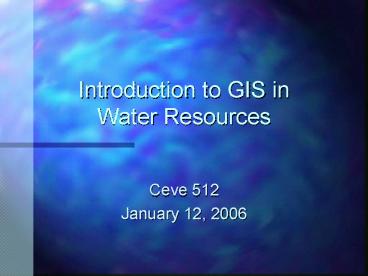Introduction to GIS in Water Resources - PowerPoint PPT Presentation
1 / 33
Title: Introduction to GIS in Water Resources
1
Introduction to GIS in Water Resources
- Ceve 512
- January 12, 2006
2
Geographic Information SystemsA Definition of GIS
- GIS is a system composed of three integral parts
- A Database
- Spatial or Map Information
- Some way to link the two
- Computer
- GIS Software
- Trained Users
- Spatial location usually a geographic location
- Information visualization of analysis of data
- System linking software, hardware, data
- Trained User a thinking explorer who is key to
the power of GIS
3
What is Not GIS?
- GPS Global Positioning System
- A Static Map Paper or Digital
- Maps are often a product of GIS
- A way to visualize the analysis
- A Software Package
http//www.physics.brocku.ca/courses/1p21/images/W
2-f12012.gif
4
What is GIS?
- A method to visualize, manipulate, analyze, and
display spatial data. - Smart Maps that link a database to
corresponding map locations. - Zoom in while still preserving information.
5
Database Composition
- Feature
- An Item or piece of information placed on a map.
- Point (1 location), line, area
- Activities
- Described with geographical pattern and
distribution. - Population maps, urban infrastructure maps
- Events
- Occurs at a point in time and can be mapped over
time. - Rainfall events
6
Combining Data from Many Sources
- Digitized and Scanned Maps
- Purchased, Internet
- Created by user
- Data Bases Tables of Data
- GPS Global Positioning System
- Accurate locations
- Field Sampling of Attributes
- Remote Sensing and Aerial Photography
7
Data Model Based on Inventory
GIS Layers combine as Geospatial Database
- Streams
- Drainage Areas
- Hydrography
- Channels
- Terrain Surfaces
- Rainfall Response
- Digital Orthophotos
8
Turning Data into Information
- Five Data Layers Features Match
- Georeferenced Overlays
Spatial Analysis Not Just A Map
9
Two Ways to Input and Visualize DataThe World in
GIS
- Raster Grid
- pixels
- A location and value
- Satellite images and aerial photos are already in
this format - Vector Linear
- Points, lines and polygons
- Features (house, lake, etc.)
- Attributes
- Size, length, type, etc.
10
Spatial Data Vector Format
11
Vector Data
- Create or Download Themes
- Polygons Outline of Texas Counties
- Lines Texas Rivers
- Points Texas Cities
12
Example Subwatersheds in Houston
- Flooded HISD schools during Tropical Storm
Allison.
13
Raster Data
- Raster Data are described by a cell grid, one
value per cell. (Elevation for Example) - Downloaded from the USGS and other government
agencies.
14
Example Rainfall (annual or event)
- Overlay previous map with rainfall values to
determine flooded areas.
15
Example Digital Elevation Model (DEM)
16
Comparison of Raster and Vector Data
17
Combining Raster and Vector Data
Integrated Raster-Vector Database
18
Aerial PhotographsDigital Orthophoto Quadrangles
(DOQs)
- USGS maps
19
Location MapsDigital Raster Graphics (DRGs)
- Topographic maps
20
Applying GIS
- Some Ways GIS is Used
- Emergency Services Fire, Police, Rescue
- Environmental Monitoring and Modeling
- Business Site Location, Delivery Systems
- Industry Transportation, Communication, Mining,
Pipelines, Healthcare - Education Research, Teaching Tool,
Administration - Wherever Spatial Data Analysis is Needed
21
Asking a Question Interaction
22
Multiple Databases can be Linked and Related
23
3D Groundwater Well Data
24
Environmental Modeling Contamination Plumes
25
Combining Various Display Methods
26
Modeling of Future Trends
27
Geo-HMS Terrain Processing
- Apply DEM to automatically create Flow Direction
Grid - Create Flow Accumulation Grid
- Choose threshold value to generate streams
- Delineate Watershed
- Sub watersheds obtained from this process
28
Flow Accumulation
- Direction of Steepest Descent
- Flow Direction Grid
29
Step 1 Terrain Processing
30
Step 2 Terrain Processing
31
Step 3 Terrain Processing
32
Sample Project Outline
- Acquire DOQs, DEMs, and DRGs
- Define watersheds and rivers using Geo-HMS
terrain processing - Create Hydrologic (HMS) model from Geo-HMS
- Input known rainfall data
- Solve flooding issues
33
Sample GIS Floodplains































